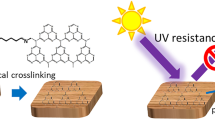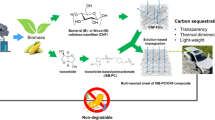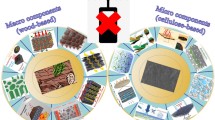Abstract
Wood is a sustainable building material that can help to achieve carbon neutralization but, because wood is easily damaged by ultraviolet (UV) light, it is important to protect wood from this harmful radiation. Here, we synthesized sustainable biomass-based carbon dots (Bio-CDs) using only microcrystalline cellulose, which was concentration-dependent and capable of absorbing short wavelength and converting it to long wavelength light emission. Furthermore, the Bio-CDs were mixed with poly (vinyl alcohol) (PVA) to produce robust optical shielding films (OSFs). The results showed that OSFs had good optical properties, which could effectively block UV and high-energy blue photons radiation by absorbing short wavelength light and converting it into longer wavelength (> 450 nm) light. The extent of UV and high-energy blue photons blocking can be easily adjusted by varying the proportion of Bio-CDs in the film. The OSFs have good optical properties and have been successfully used to protect wood from UV damage. This study, which uses environmentally friendly and simple methodology, provides an example of sustainable research.







Similar content being viewed by others
Data availability
All relevant data are within the paper and its Supporting Information files.
References
Palander T, Haavikko H, Kärhä K (2018) Towards sustainable wood procurement in forest industry-the energy efficiency of larger and heavier vehicles in Finland. Renew Sust Energ Rev 96:100–118. https://doi.org/10.1016/j.rser.2018.07.043
Voshell S, Mäkelä M, Dahl O (2018) A review of biomass ash properties towards treatment and recycling. Renew Sust Energ Rev 96:479–486. https://doi.org/10.1016/j.rser.2018.07.025
Head M, Bernier P, Levasseur A, Beauregard R, Margni M (2019) Forestry carbon budget models to improve biogenic carbon accounting in life cycle assessment. J Clean Prod 213:289–299. https://doi.org/10.1016/j.jclepro.2018.12.122
Wang J, Zhang D, Chu F (2021) Wood-derived functional polymeric materials. Adv Mater 33:e2001135. https://doi.org/10.1002/adma.202001135
Mi R, Chen C, Keplinger T, Pei Y, He S, Liu D, Li J, Dai J, Hitz E, Yang B, Burgert I, Hu L (2020) Scalable aesthetic transparent wood for energy efficient buildings. Nat Commun 11:3836. https://doi.org/10.1038/s41467-020-17513-w
Jia C, Chen C, Mi R, Li T, Dai J, Yang Z, Pei Y, He S, Bian H, Jang S, Zhu J, Yang B, Hu L (2019) Clear wood toward high-performance building materials. ACS Nano 13:9993–10001. https://doi.org/10.1021/acsnano.9b00089
Li W, Chen Z, Yu H, Li J, Liu S (2021) Wood-derived carbon materials and light-emitting materials. Adv Mater 33:e2000596. https://doi.org/10.1002/adma.202000596
Guo H, Klose D, Hou Y, Jeschke G, Burgert I (2017) Highly efficient UV protection of the biomaterial wood by a transparent TiO2/Ce xerogel. ACS Appl Mater Interfaces 9:39040–39047. https://doi.org/10.1021/acsami.7b12574
Xia Q, Chen C, Yao Y, He S, Wang X, Li J, Gao J, Gan W, Jiang B, Cui M, Hu L (2021) In situ lignin modification toward photonic wood. Adv Mater 33:e2001588. https://doi.org/10.1002/adma.202001588
Yang H, Liu Y, Guo Z, Lei B, Zhuang J, Zhang X, Liu Z, Hu C (2019) Hydrophobic carbon dots with blue dispersed emission and red aggregation-induced emission. Nat Commun 10:1789. https://doi.org/10.1038/s41467-019-09830-6
Varganici C, Rosu L, Rosu D, Mustata F, Rusu T (2020) Sustainable wood coatings made of epoxidized vegetable oils for ultraviolet protection. Environ Chem Lett 19:307–328. https://doi.org/10.1007/s10311-020-01067-w
Yuan B, Guo M, Murugadoss V, Song G, Guo Z (2021) Immobilization of graphitic carbon nitride on wood surface via chemical crosslinking method for UV resistance and self-cleaning. Adv Compos Hybrid Mater 4:286–293. https://doi.org/10.1007/s42114-021-00235-y
Dong Y, Yan Y, Ma H, Zhang S, Li J, Xia C, Shi S, Cai L (2017) In-situ chemosynthesis of ZnO nanoparticles to endow wood with antibacterial and UV-resistance properties. J Mater Sci Technol 33:266–270. https://doi.org/10.1016/j.jmst.2016.03.018
Lim S, Shen W, Gao Z (2015) Carbon quantum dots and their applications. Chem Soc Rev 44:362–381. https://doi.org/10.1039/c4cs00269e
Desmond L, Phan A, Gentile P (2021) Critical overview on the green synthesis of carbon quantum dots and their application for cancer therapy. Environ Sci-Nano 8:848–862. https://doi.org/10.1039/d1en00017a
Wareing T, Gentile P, Phan A (2021) Biomass-based carbon dots: current development and future perspectives. ACS Nano 15:15471–15501. https://doi.org/10.1021/acsnano.1c03886
Ge M, Han Y, Ni J, Li Y, Han S, Li S, Yu H, Zhang C, Liu S, Li J, Chen Z (2021) Seeking brightness from nature: sustainable carbon dots-based AIEgens with tunable emission wavelength from natural rosin. Chem Eng J 413:127457. https://doi.org/10.1016/j.cej.2020.127457
Ge M, Huang X, Ni J, Han Y, Zhang C, Li S, Cao J, Li J, Chen Z, Han S (2021) One-step synthesis of self-quenching-resistant biomass-based solid-state fluorescent carbon dots with high yield for white lighting emitting diodes. Dyes Pigments 185:108953. https://doi.org/10.1016/j.dyepig.2020.108953
Cai X, Lin Y, Li Y, Chen X, Wang Z, Zhao X, Huang S, Zhao Z, Tang B (2021) BioAIEgens derived from rosin: how does molecular motion affect their photophysical processes in solid state? Nat Commun 12:1773. https://doi.org/10.1038/s41467-021-22061-y
Liu H, Du H, Zheng T, Liu K, Ji X, Xu T, Zhang X, Si C (2021) Cellulose based composite foams and aerogels for advanced energy storage devices. Chem Eng J. https://doi.org/10.1016/j.cej.2021.130817
Liu H, Xu T, Cai C, Liu K, Liu W, Zhang M, Du H, Si C, Zhang K (2022) Multifunctional superelastic, superhydrophilic, and ultralight nanocellulose-based composite carbon aerogels for compressive supercapacitor and strain sensor. Adv Funct Mater. https://doi.org/10.1002/adfm.202113082
Xu T, Du H, Liu H, Liu W, Zhang X, Si C, Liu P, Zhang K (2021) Advanced nanocellulose-based composites for flexible functional energy storage devices. Adv Mater 33:e2101368. https://doi.org/10.1002/adma.202101368
Zhang M, Du H, Liu K, Nie S, Xu T, Zhang X, Si C (2021) Fabrication and applications of cellulose-based nanogenerators. Adv Compos Hybrid Mater 4:865–884. https://doi.org/10.1007/s42114-021-00312-2
Xu T, Liu K, Sheng N, Zhang M, Liu W, Liu H, Dai L, Zhang X, Si C, Du H, Zhang K (2022) Biopolymer-based hydrogel electrolytes for advanced energy storage/conversion devices: properties, applications, and perspectives. Energy Storage Mater 48:244–262. https://doi.org/10.1016/j.ensm.2022.03.013
Han Y, Huang X, Liu J, Ni J, Bai Y, Zhao B, Han S, Zhang C (2022) Seeking eye protection from biomass: carbon dot-based optical blocking films with adjustable levels of blue light blocking. J Colloid Interf Sci 617:44–52. https://doi.org/10.1016/j.jcis.2022.02.115
Park S, Yang H, Moon B (2019) Ultraviolet to blue blocking and wavelength convertible films using carbon dots for interrupting eye damage caused by general lighting. Nano Energy 60:87–94. https://doi.org/10.1016/j.nanoen.2019.03.043
Wang R, Meng Z, Yan X, Tian T, Lei M, Pashameah R, Abo-Dief H, Algadi H, Huang N, Guo Z, Tang H (2023) Tellurium intervened Fe-N codoped carbon for improved oxygen reduction reaction and high-performance Zn-air batteries. J Mater Sci Technol 137:215–222. https://doi.org/10.1016/j.jmst.2022.07.041
Liu S, Du H, Liu K, Ma M, Kwon Y, Si C, Ji X, Choi S, Zhang X (2021) Flexible and porous Co3O4-carbon nanofibers as binder-free electrodes for supercapacitors. Adv Compos Hybrid Mater 4:1367–1383. https://doi.org/10.1007/s42114-021-00344-8
Chen N, Wang C, Ali O, Mahmoud S, Shi Y, Ji Y, Algadi H, EI-Bahy S, Huang M, Guo Z, Cui D, Wei H (2022) MXene@nitrogen-doped carbon films for supercapacitor and piezoresistive sensing applications. Compos A 163:107174. https://doi.org/10.1016/j.compositesa.2022.107174
Hou C, Yang W, Kimura H, Xie X, Zhang X, Sun X, Yu Z, Yang X, Zhang Y, Wang B, Xu B, Sridhar D, Algadi H, Guo Z, Du W (2023) Boosted lithium storage performance by local build-in electric field derived by oxygen vacancies in 3D holey N-doped carbon structure decorated with molybdenum dioxide. J Mater Sci Technol 142:185–195. https://doi.org/10.1016/j.jmst.2022.10.007
Xue B, Yang Y, Sun Y, Fan J, Li X, Zhang Z (2019) Photoluminescent lignin hybridized carbon quantum dots composites for bioimaging applications. Int J Biol Macromol 122:954–961. https://doi.org/10.1016/j.ijbiomac.2018.11.018
Ozyurt D, Shafqat S, Pakkanen T, Hocking R, Mouritz A, Fox B (2021) Aggregation induced emission transformation of liquid and solid-state N-doped graphene quantum dots. Carbon 175:576–584. https://doi.org/10.1016/j.carbon.2021.01.026
Liu H, Xu T, Liang Q, Zhao Q, Zhao D, Si C (2022) Compressible cellulose nanofibrils/reduced graphene oxide composite carbon aerogel for solid-state supercapacitor. Adv Compos Hybrid Mater 5:1168–1179. https://doi.org/10.1007/s42114-022-00427-0
Wang Z, Liu Y, Zhen S, Li X, Zhang W, Sun X, Xu B, Wang X, Gao Z, Meng X (2020) Gram-scale synthesis of 41% efficient single-component white-light-emissive carbonized polymer dots with hybrid fluorescence/phosphorescence for white Light-Emitting Diodes. Adv Sci 7:1902688. https://doi.org/10.1002/advs.201902688
Zeng M, Li T, Liu Y, Lin X, Zu X, Mu Y, Chen L, Huo Y, Qin Y (2022) Cellulose-based photo-enhanced persistent room-temperature phosphorescent materials by space stacking effects. Chem Eng J. https://doi.org/10.1016/j.cej.2022.136935
Xu M, Dong C, Xu J, Rehman S, Wang Q, Osipov V, Jiang K, Wang J, Bi H (2022) Fluorinated carbon dots/carboxyl methyl cellulose sodium composite with a temperature-sensitive fluorescence/phosphorescence applicable for anti-counterfeiting marking. Carbon 189:459–466. https://doi.org/10.1016/j.carbon.2021.12.077
Chen W, Hong L, Wu Y, Yang M, Zhang X, Zhu S, He M, Xie J, Shi Z (2022) Fluorescent probe of nitrogen-doped carbon dots derived from biomass for the sensing of MnO4-in polluted water based on inner filter effect. Adv Compos Hybrid Mater 5:2378–2386. https://doi.org/10.1007/s42114-022-00443-0
Vijeata A, Chaudhary G, Umar A, Chaudhary S (2021) Distinctive solvatochromic response of fluorescent carbon dots derived from different components of aegle marmelos plant. Eng Sci 15:197–209. https://doi.org/10.30919/es8e512
Liu B, Chu B, Wang Y, Hu L, Hu S, Zhang X (2021) Carbon dioxide derived carbonized polymer dots for multicolor light-emitting diodes. Green Chem 23:422–429. https://doi.org/10.1039/d0gc03333b
Jiang K, Gao X, Feng X, Wang Y, Li Z, Lin H (2020) Carbon dots with dual-emissive, robust, and aggregation-induced room-temperature phosphorescence characteristics. Angew Chem Int Ed Engl 59:1263–1269. https://doi.org/10.1002/anie.201911342
Han Y, Tang B, Wang L, Bao H, Lu Y, Guan C, Zhang L, Le M, Liu Z, Wu M (2020) Machine-learning-driven synthesis of carbon dots with enhanced quantum yields. ACS Nano 14:14761–14768. https://doi.org/10.1021/acsnano.0c01899
Guo J, Li H, Ling L, Li G, Cheng R, Lu X, Xie A, Li Q, Wang C, Chen S (2019) Green synthesis of carbon dots toward anti-counterfeiting. ACS Sustain Chem Eng 8:1566–1572. https://doi.org/10.1021/acssuschemeng.9b06267
Kumari M, Chaudhary G, Chaudhary S, Umar A (2022) Rapid analysis of trace sulphite ion using fluorescent carbon dots produced from single use plastic cups. Eng Sci 17:101–112. https://doi.org/10.30919/es8d556
Ba X, Zhang L, Yin Y, Jiang F, Jiang P, Liu Y (2020) Luminescent carbon dots with concentration-dependent emission in solution and yellow emission in solid state. J Colloid Interface Sci 565:77–85. https://doi.org/10.1016/j.jcis.2020.01.007
Ni J, Huang X, Bai Y, Zhao B, Han Y, Han S, Xu T, Si C, Zhang C (2022) Resistance to aggregation-caused quenching: chitosan-based solid carbon dots for white light-emitting diode and 3D printing. Adv Compos Hybrid Mater 5:1865–1875. https://doi.org/10.1007/s42114-022-00483-6
Chen Y, Zheng M, Xiao Y, Dong H, Zhang H, Zhuang J, Hu H, Lei B, Liu Y (2016) A Self-quenching-resistant carbon-dot powder with tunable solid-state fluorescence and construction of dual-fluorescence morphologies for white light-emission. Adv Mater 28:312–318. https://doi.org/10.1002/adma.201503380
Bhattacharyya S, Ehrat F, Urban P, Teves R, Wyrwich R, Doblinger M, Feldmann J, Urban A, Stolarczyk J (2017) Effect of nitrogen atom positioning on the trade-off between emissive and photocatalytic properties of carbon dots. Nat Commun 8:1401. https://doi.org/10.1038/s41467-017-01463-x
Zhang T, Zhao F, Li L, Qi B, Zhu D, Lu J, Lu C (2018) Tricolor White-light-emitting carbon dots with multiple-cores@shell structure for WLED application. ACS Appl Mater Interfaces 10:19796–19805. https://doi.org/10.1021/acsami.8b03529
Gao X, Zhou X, Ma Y, Qian T, Wang C, Chu F (2019) Facile and cost-effective preparation of carbon quantum dots for Fe3+ ion and ascorbic acid detection in living cells based on the “on-off-on” fluorescence principle. Appl Surf Sci 469:911–916. https://doi.org/10.1016/j.apsusc.2018.11.095
Funding
This study was funded by the National Key Research and Development Program (2021YFD2200601).
Author information
Authors and Affiliations
Contributions
The first two authors contributed equally to this work. Shiyan Han and Wenji Yu designed the research. Youqi Han carried out the experiments, data analysis, and drawing of figures. Yuning Wang, Yibing Bai, and Bin Zhao sorted the data and figures. Shujun Li and Chuanling Si carried out mechanism analysis. Zhijun Chen, Yahui Zhang, Haipeng Yu, and Chunlei Zhang carried out supervision. Youqi Han wrote the manuscript. All authors have given approval to the final version of the manuscript.
Corresponding authors
Ethics declarations
Conflict of interest
The authors declare no competing interests.
Additional information
Publisher's Note
Springer Nature remains neutral with regard to jurisdictional claims in published maps and institutional affiliations.
Supplementary Information
Below is the link to the electronic supplementary material.
Supplementary file2 (MP4 3128 kb)
Rights and permissions
Springer Nature or its licensor (e.g. a society or other partner) holds exclusive rights to this article under a publishing agreement with the author(s) or other rightsholder(s); author self-archiving of the accepted manuscript version of this article is solely governed by the terms of such publishing agreement and applicable law.
About this article
Cite this article
Han, Y., Wang, Y., Zhao, B. et al. Carbon dots: building a robust optical shield for wood preservation. Adv Compos Hybrid Mater 6, 39 (2023). https://doi.org/10.1007/s42114-022-00619-8
Received:
Revised:
Accepted:
Published:
DOI: https://doi.org/10.1007/s42114-022-00619-8




